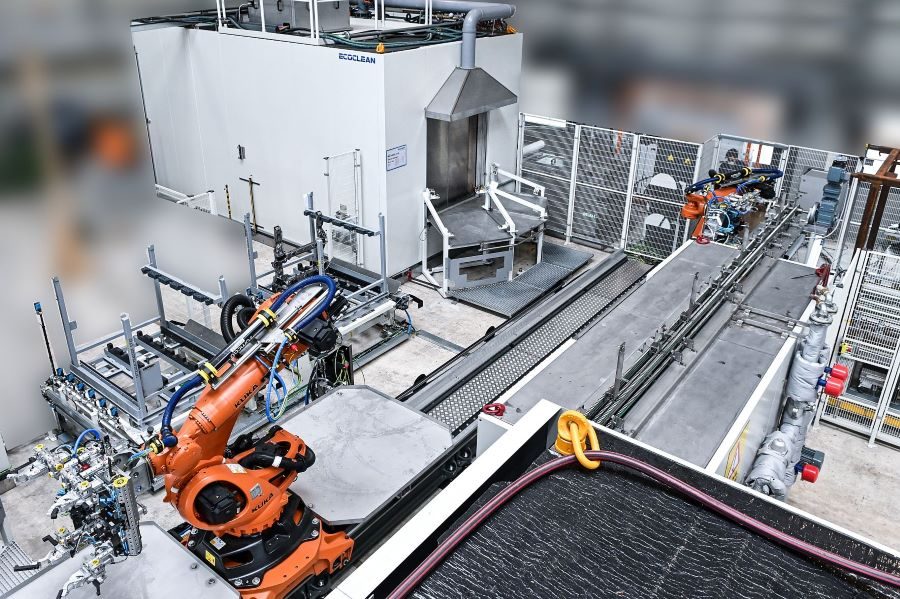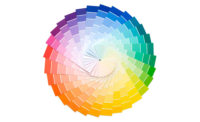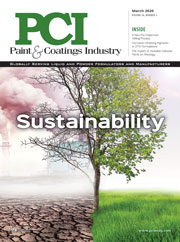New Water Jetting Process Cleans Weld Seams Sustainably and Efficiently




Electric and hybrid vehicles are changing the way vehicles are built in ways that go far beyond the drive technology. For example, due to the weight of the battery, integral subfames now need a higher load-bearing capacity. The redesign of these axle components is also prompting many vehicle manufacturers to reconsider and reassess their production processes. One of these processes is the cleaning step to remove impurities such as silicate islands, scale and smoke residues formed during welding; these can cause major quality issues in the subsequent cathodic dip painting process and lead to corrosion damage. The cleaning technology generally used is blasting with a solid medium, for example corundum. To remove dust and abrasive residues from the parts prior to cathodic dip painting, another cleaning step in a separate machine is required.
Focus On Cost Efficiency, Sustainability and Occupational Health and Safety
These conventional blasting processes with an additional aqueous cleaning step are wear-intensive and costly. Therefore, when designing a new production line for integral subframes, the project planner of a renowned German OEM sought information at parts2clean about ways to optimize this cleaning process. On the one hand, the aim was to clean weld seams with same or better results, but cheaper, with less maintenance, and saving on resources. On the other hand, the dust pollution occurring in the vicinity of the solid-state blasting machines due to fragmented abrasive needed to be eliminated in order to improve working conditions.
Removing Welding Residues - Parts Cleaning Included
The planner found what he was looking for with Ecoclean's EcoCbooster technology. The patented process employs medium-pressure water jetting in the range between 300 and 700 bar without addition of abrasives. Through the use of ultrasound, the pre-stressed column of water turns into an ultra-high frequency pulsating water jet after exiting the nozzle. This imparts a much higher kinetic energy to the jet, such that it reliably and reproducibly eliminates silicate and weld spatter as well as scale and smoke residues from the surfaces in a clearly defined operating window. Feed rates of up to 800 mm per second are possible, with a robot moving either the workpiece or the nozzle tool.
The part is also cleaned at the same time the welding residues are removed, thus dispensing with the need for an additional cleaning step and the corresponding machine. This not only noticeably decreases investments related to the cleaning process, but also ensures more competitive unit costs because operating costs are significantly reduced. Another factor contributing to the high economic and resource efficiency of the process is the effective treatment of the process water, which is mixed with a corrosion protection medium so that it can be recirculated for a long time.
Selectively Cleaning External and Internal Geometries
The effective range of the water jet can be precisely adapted to the application by using different nozzle geometries, for example fan and solid-jet nozzles as well as lances. Among other things, this enables not only the outer but also the inner contours of the integral subframes to be selectively cleaned, in contrast to conventional jet-cleaning processes with abrasives.
Process Engineering and Validation in Technology Centre
The process parameters, such as nozzle geometry, pressure and feed rate, were precisely adjusted using a special test set-up at the manufacturer's Technology Centre in Monschau. To validate the new water jetting process, integral subframes were coated in the cathodic dip painting line cleaning and then subjected to a lengthy salt spray test. The results were impressive: The weld seams were cleaner after treatment with the pulsating water jet than after blasting with abrasive media, and any discoloration from the welding process still visible on the surface had no effect on the quality of the paint finish. The high corrosion protection requirements had been met. The new cleaning solution also proved to be a good choice in terms of cost/benefit.
Fully Automatic Jetting, Cleaning and Drying In 50-Second Cycles
In order to implement the developed process in a fully automated machine concept, an integral subframe had to be jetted, cleaned and dried within 50 seconds. To meet this requirement, the cleaning machine has three independently functioning jetting modules with integrated manipulator, a hot air dryer, one robot each for loading and unloading, and a bath treatment unit for the process water.
Pallet cages loaded with several integral subframes to be processed are transported to the machine. The machine’s loading robot picks up the parts and places them on the transfer stations of the jet modules. The manipulator of the respective module picks up the part and moves it in a defined sequence to the jet tool, treating the welding contours in a specific manner. After cleaning, the manipulator places the integral subframe on a clean surface. From here, the loading robot takes it to the drying step. On exiting the dryer, the subframe is picked up by the unloading robot and hooked into the rack for painting.
To eliminate the transport path between the welding and cleaning process, the EcoCbooster can also be connected directly to the welding cell.
The vehicle manufacturer has been using the new cleaning system in series production since mid-2020. Due to the optimizations achieved, the company is now considering integrating the new cleaning solution into further production lines for integral subframes.
For more information, visit www.ecoclean-group.net.
Looking for a reprint of this article?
From high-res PDFs to custom plaques, order your copy today!









